
Choosing a birch
Our tips to make the right choice!
Contents
A very hardy tree, the birch is very popular due to its remarkable, decorative and varied bark. Its foliage is deciduous, taking on a beautiful warm hue in autumn, which can also vary from one variety to another. Depending on its size and shape, the birch can be used in different ways. There are many factors to consider before purchasing your tree. That’s why our buying guide can help clarify things by providing examples of birches for every situation. Here are our tips for choosing yours based on different criteria, whether you have a large or small garden!
According to height
Birch trees come in a variety of sizes and are known for their rapid growth during their early years (with the exception of dwarf birches). There are three categories of birches:
Dwarf birches
Measuring less than one metre tall, dwarf birches are the smallest. These are shrubs rather than trees. The typical species Betula nana reaches about 60 cm in height and tends to spread to a width of up to 1.20 m. In our range, the variety Betula nana ‘Golden Treasure’ forms a compact bush of 90 cm in all directions.
Medium-sized birches
Birches that do not exceed 20 metres in height are very numerous, with some not exceeding 10 metres:
- The Betula pendula ‘Youngii’, Betula pendula ‘Royal Frost’, and Betula pendula ‘Golden Cloud’ are small trees that grow moderately to reach heights between 3 and 6 m.
- Somewhat larger, the Chinese birch and the black birches ‘Shiloh Splash’ and ‘Heritage’ can grow to approximately 8 – 9 m tall.
- Finally, like the black birch and Betula utilis ‘Jacquemontii’ and ‘Doorenboos’, the height of some cultivars of white birch varies between 12 and 18 m: Betula pendula ‘Fastigiata’, Betula pendula ‘Tristis’, and Betula pendula ‘Crispa’.
Large Birches
At maturity, these trees reach heights of 20 to 25 m. This is the case for the paper birch (Betula papyrifera), the common birch (in Latin, Betula pendula, alba or verrucosa), and the downy birch (Betula pubescens).

Betula nana (photo Wikipedia), Betula pendula ‘Youngii’ (photo Babij) and Betula pendula (photo A. Rockstein)
Read also
Birches: planting, pruning and careAccording to its silhouette
The majority of birches have an upright habit, with a conical or rounded crown, giving these trees a light silhouette. But that’s not all! Here’s an overview of the different silhouettes a birch can have:
- The common birch allows its main branches to rise. Then, the supple and thin twigs delicately droop. This is why it is called Betula pendula in Latin. Moreover, this birch is also known as the white birch or verrucate birch due to the small resinous warts present on the young branches. The variety Betula pendula ‘Crispa’ is also a good example of a weeping birch.
- In contrast, the cultivar Betula pendula ‘Fastigiata’ behaves differently and adopts a fastigiate habit (columnar).
- Some birches have a pyramidal crown: for example, the Betula papyrifera, the pubescent birch, or Betula utilis var. jacquemontii ‘Doorenbos’.
- Very different, Betula pendula ‘Youngii’ and Betula pendula ‘Tristis’ resemble the weeping willow with their very drooping branches.
- Among the smaller birches, dwarf birches develop into a spherical bush, sometimes creeping.
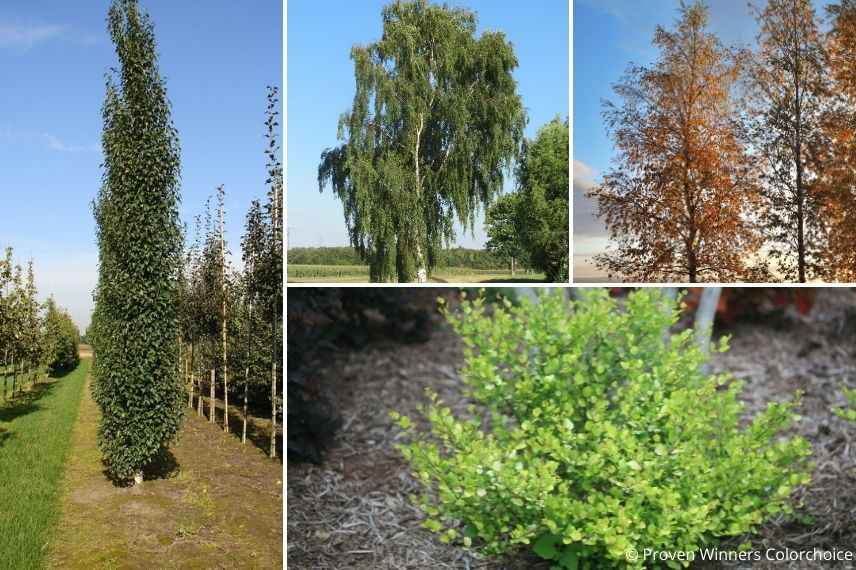
Fastigiate birch (Betula pendula ‘Fastigiata’), weeping birch, conical birch, and dwarf birch ‘Golden Treasure’
Discover other Betula - Birch tree
View all →Available in 1 sizes
Available in 1 sizes
Available in 2 sizes
Available in 1 sizes
Available in 2 sizes
Available in 1 sizes
Available in 2 sizes
Available in 1 sizes
Available in 1 sizes
Available in 1 sizes
According to the foliage
Birches have a deciduous foliage that is very often triangular in shape. The leaves are also more or less dentate, elongated, pointed, and sometimes downy depending on the species: doubly dentate with an elongated and very fine tip in the silver birch (Betula pendula), simply dentate and pilous in the Betula pubescens, or slightly more ovate in the black birch. However, there are exceptions that stand out. For example, the weeping birch ‘Crispa’ is distinguished by its deciduous leaves that are very finely cut and laciniate. We should also mention the dwarf birch (Betula nana) whose foliage consists of tiny, glossy leaves with a rounded and dentate edge.
Regarding colour, the foliage offers many shades of green, but also more original hues. The Betula pendula ‘Royal Frost’ displays leaves of an intense chocolate purple colour. The black birch ‘Shiloh Splash’ boasts bright green foliage variegated with white. Finally, for golden foliage, opt for the dwarf birch ‘Golden Treasure’ or the white birch ‘Golden Cloud’.
Be aware that birches take on beautiful autumn colours, ranging from golden yellow to orange-yellow, sometimes red, before shedding their leaves for the winter period.

Green leaves of Betula pendula ‘Youngii’, purple leaves of Betula pendula ‘Royal Frost’, rounded leaves of Betula ‘Nana’, and golden foliage in autumn
Read also
7 amazing birches to discoverAccording to the beauty of the bark
Birch is particularly valued for its decorative bark that peels in strips, revealing new hues.
White barks:
- There are many birches with white bark, but the one with the whitest trunk is the Himalayan birch Betula utilis ‘Jacquemontii’.
- The Betula pendula is covered in white bark marked with black fissures that give it all its charm.
- The Betula papyrifera is known as the “paper birch” because its bark peels off significantly, forming rolls of paper. Native Americans also used this birch bark in canoe making, hence it is also nicknamed “canoe birch”.
- In a contrasting garden, opt for the Betula pendula ‘Royal Frost’ whose very white bark contrasts with the dark purple foliage.
- Other silver-white barked birches include the weeping birches ‘Crispa’, ‘Tristis’, ‘Youngii’, and ‘Golden Cloud’.
Brown barks:
- The Betula albosinensis ‘Fascination’ reveals a coppery bark, changing with age to shades of pink, brown, orange, and grey.
- The Betula nigra ‘Heritage’ offers beautiful shades of pink, cream white, and brown while exfoliating heavily.
Black barks:
Just like the ‘Heritage’ variety, the species type Betula nigra exfoliates heavily. Initially cinnamon-coloured, it darkens over time to become almost black, hence its name black birch.
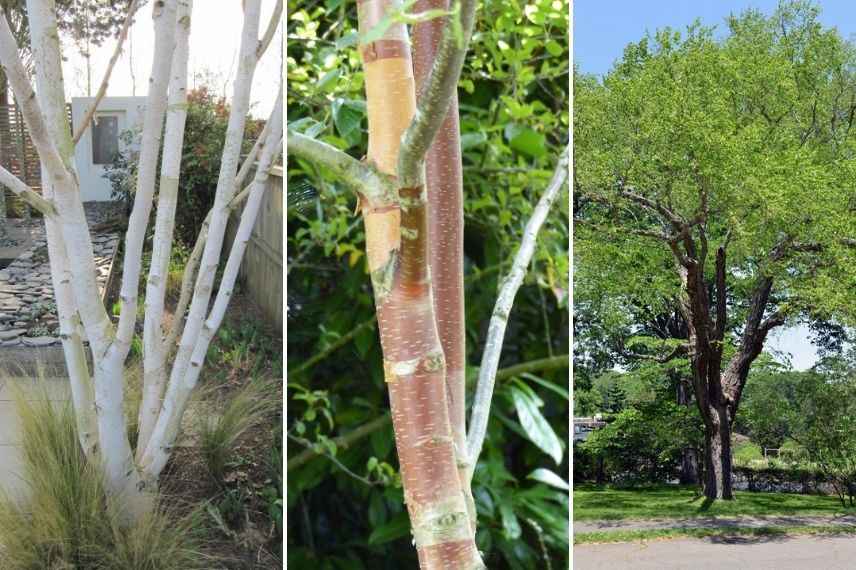
White bark birch (photo Leonara Enking – Flickr), brown bark birch (Betula albosinensis ‘Fascination’), and black birch (photo Plant Image Library)
Depending on the nature of your soil
When it comes to soil, birch is generally not very demanding. It prefers cool, neutral, well-drained, humus-bearing soil, but it also adapts to poor, clayey, sandy, peaty, slightly acidic, or occasionally dry soil.
However, note that the black birch prefers very moist soils. This is also why it has been nicknamed the “river birch.” Additionally, the downy birch also prefers damp, waterlogged locations.
According to the use
Presenting a variety of habits and aspects, birch can be used in different contexts in cool climates:
In groups
Medium and large birches naturally find their place in large gardens. Create a grove by mixing species and varieties with ornamental bark: Betula nigra ‘Heritage’, Betula utilis jacquemontii and Betula albosinensis ‘Fascination’. Note that your birch can be planted with other trees: maple, hornbeam, false acacia, weeping willow, and conifers, for example. Medium-sized birches can serve as a backdrop in a flower bed: Betula nigra ‘Shiloh Splash’ with its variegated foliage or Betula pendula ‘Golden Cloud’ with its golden foliage. However, we remind you that this deciduous tree has a shallow root system, and you will need to carefully choose the plants you install nearby, lest they suffer from root competition.
In isolation
Weeping birches with pendulous branches are best showcased when planted alone: ‘Crispa’, ‘Tristis’, ‘Youngii’. For a more striking effect, we recommend planting the purple birch ‘Royal Frost’ in isolation. You can also create a coppice of three isolated birches. This involves planting three young plants of the same species in the same planting hole, to create a cluster of several trees.
In alignment
The slender silhouette of birches with white bark is perfect for alignments (for example, Betula pendula). These trunks illuminate pathways or can serve to delineate areas. Also consider Betula pendula ‘Fastigiata’ with its columnar habit, which is perfectly suited for this use.
In pots, beds, rockeries, or slopes
Dwarf birches (Betula nana) are well-suited for pot planting if you do not have a garden or if your garden is modest in size. Due to their compact habit and moderate growth, they can also be planted in the heart of a bed of perennial plants and shrubs or on a slope. The golden foliage of Betula nana ‘Golden Treasure’ is a lovely asset for dressing small spaces.
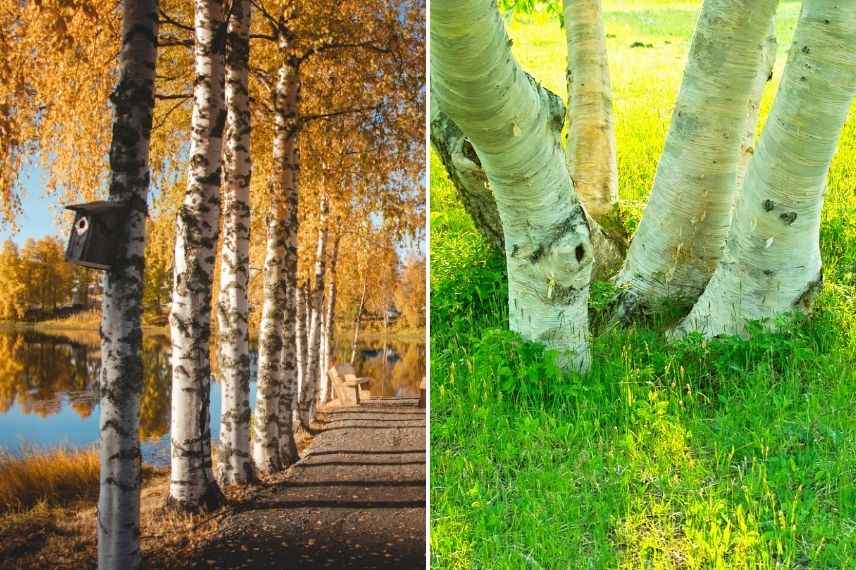
On the left, birches in alignment, on the right, a coppice of isolated birches
For further reading
- Find our wide range of birches on our site
- Discover our article to learn more about Birches: planting, pruning and maintenance
- Learn more about the most beautiful barks
- Our selection of 7 amazing birches to discover and 10 trees with a weeping habit
- Follow our tutorial step by step: How to dry birch leaves?
- Subscribe!
- Contents
































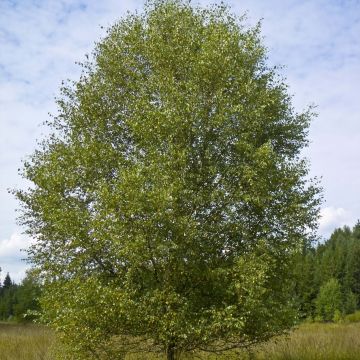
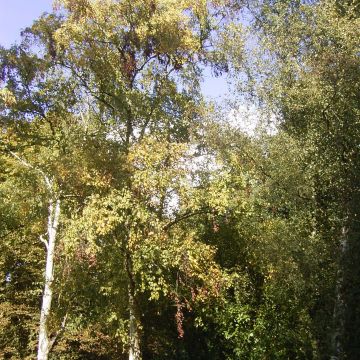
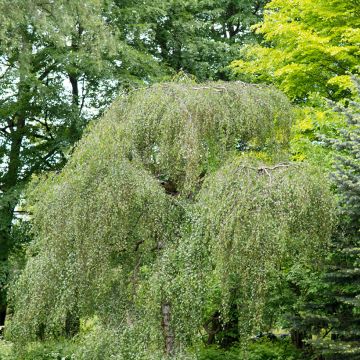
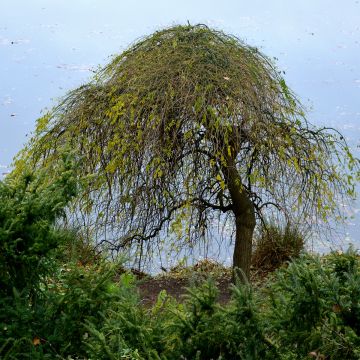

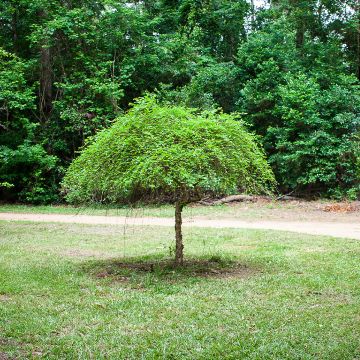

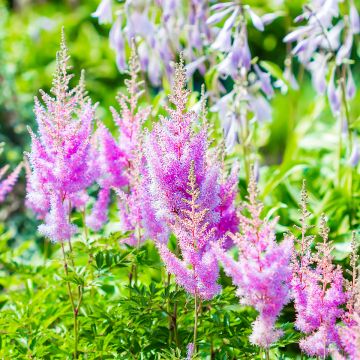

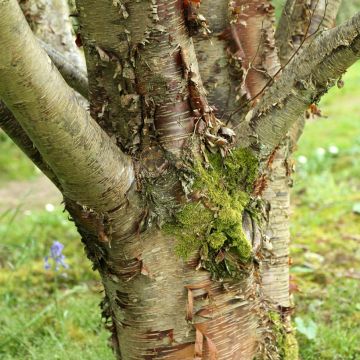
Comments